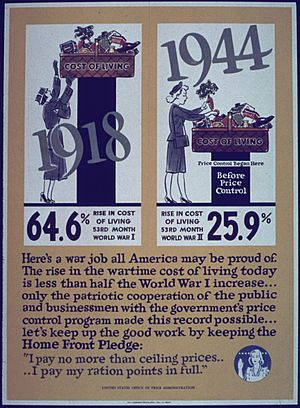Price controls facts for kids
In economics, price control is when the government sets limits on how much money can be charged for a certain product or service. This happens in a specific market. The government might set an exact price, or it might set a range, like a lowest price and a highest price.
Governments usually do this to make sure important things, like staple food (foods people eat every day), stay affordable for everyone. They also do it to stop people from charging way too much for something, which is called price gouging. Another example is setting a minimum wage. This is the lowest salary or pay that employers must give to their workers.
Contents
Why Price Controls Can Cause Problems
The idea behind price control sounds good, but it can cause issues. In economics, there's a rule called the Law of Supply and Demand. This law says that the price of something depends on how much of it is available (supply) compared to how much people want it (demand).
If the government sets a price that is lower than what the market would naturally charge, more people will want to buy that product. It seems like a good deal! However, the amount of the product available (the supply) might not be able to increase. This means that in the long run, there won't be enough of the product for everyone who wants it. This situation is called a shortage.
Past Examples of Price Controls
Price controls have been tried many times throughout history. They often lead to unexpected problems.
Diocletian's Price Limits
Around 300 AD, a Roman emperor named Diocletian tried to control prices. A writer named Lactantius said that Diocletian had made things very expensive with taxes. So, he made a law to limit prices. But this caused big problems. People were afraid to sell their goods, and there wasn't enough of anything. The scarcity (not enough goods) became worse than before. In the end, the law had to be removed because it was hurting too many people.
Just like with Diocletian's rule, shortages often lead to black markets. A black market is where people sell goods illegally at much higher prices than the controlled price. When price controls are finally removed, prices usually go up quickly. This can be a shock to the economy for a short time.
Gas Shortages in the 1970s
Another example happened in the United States between 1973 and 1974. There was an Arab oil embargo, which meant less oil was coming into the country. The U.S. government put price controls on fuel. They set the price of gas very low.
Because the price was so low, people wanted to buy a lot of gas. But there wasn't enough gas available at that low price. This led to very long lines of cars at gas stations. Many stations even closed because they ran out of fuel. The fixed price was lower than what the market would normally pay. As a result, the gas quickly disappeared. When the government finally removed the price controls on gasoline, the shortages ended, and the long lines at gas pumps disappeared.
What Experts Say
Nobel Prize winner Milton Friedman was a famous economist. He once said, "We economists don't know much, but we do know how to create a shortage." He explained that if you want to create a shortage of tomatoes, just make a law that stores can't sell them for more than two cents per pound. Instantly, there would be no tomatoes to buy. He said it's the same with oil or gas. This shows that setting prices too low can stop people from wanting to sell those items.
Images for kids
-
Protesters call for an increased legal minimum wage as part of the "Fight for $15" effort to require a $15 per hour minimum wage in 2015. A government-set minimum wage is a price floor on the price of labour.
See also
 In Spanish: Control de precios para niños
In Spanish: Control de precios para niños





